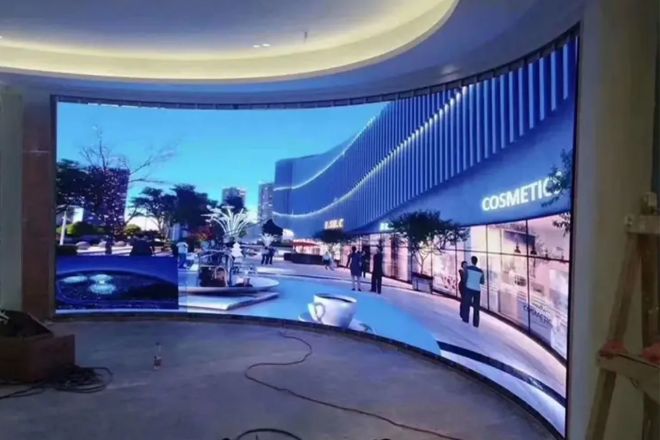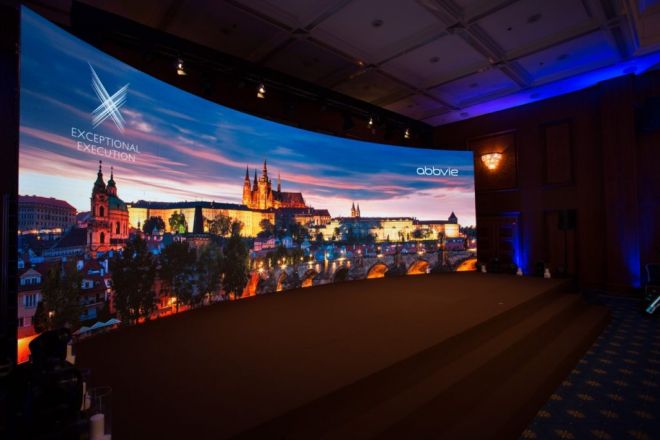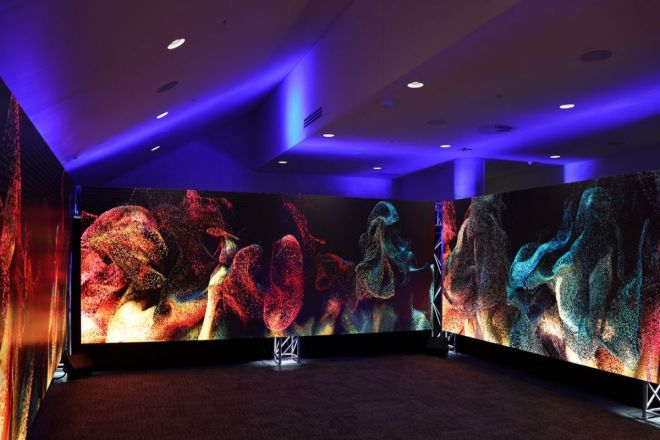مقدمة

في العصر الرقمي اليوم، شاشات عرض LED أصبحت أداة مهمة لنقل المعلومات والعرض المرئي.
بالنسبة للمستهلكين الذين يرغبون في شراء شاشات عرض LED، من المهم فهم متوسط العمر المتوقع لها، لأنه يؤثر بشكل مباشر على العائد على الاستثمار، وتكاليف التشغيل على المدى الطويل، وسهولة الصيانة.
تهدف هذه المقالة إلى تزويد المشترين بمجموعة من الأساليب العلمية والفعالة لمساعدتهم على تقييم عمر شاشات العرض LED بدقة.
1. لماذا يجب الاهتمام بعمر شاشات العرض LED؟
إن الاهتمام بعمر شاشات العرض LED مهم في العديد من الجوانب، والعائد على الاستثمار، وتكاليف التشغيل، وتجربة المستخدم التي ذكرتها هي الأسباب الأساسية.
1) العائد على الاستثمار:
باعتبارها استثمارًا رئيسيًا، فإن متوسط العمر المتوقع لشاشات العرض LED يؤثر بشكل مباشر على عائد الاستثمار. تعني شاشة العرض طويلة العمر أن المستخدمين لا يحتاجون إلى استبدالها أو ترقيتها بشكل متكرر خلال نفس الفترة الزمنية، وبالتالي توفير الكثير من تكاليف إعادة الاستثمار.
وهذا مهم بشكل خاص للشركات أو المعلنين أو أي مكان يحتاج إلى عرض المعلومات لفترة طويلة لأنهم يستطيعون الاستمتاع بفوائد الاستثمار لفترة طويلة دون القلق بشأن الحاجة إلى الاستثمار مرة أخرى على المدى القصير بسبب شيخوخة المعدات.
2) تكاليف التشغيل:
بالإضافة إلى الاستثمار الأولي، فإن تكلفة تشغيل شاشة العرض LED هي أيضًا عامل مهم يجب مراعاته. بمرور الوقت، قد تتآكل مكونات الشاشة أو تتقدم في العمر أو تفشل، مما يؤدي إلى زيادة تكاليف الصيانة.
إذا كانت الشاشة ذات عمر قصير، فإن الصيانة واستبدال المكونات ستكون أكثر تكرارًا، مما يزيد من تكاليف التشغيل الإجمالية. وعلى النقيض من ذلك، يمكن للشاشة ذات العمر الطويل أن تقلل من هذه النفقات الإضافية وتجعل تكاليف التشغيل أكثر قابلية للتحكم.
بالإضافة إلى ذلك، فإن فهم عمر الشاشة يمكن أن يساعد أيضًا في وضع خطة صيانة معقولة. من خلال فحص الأجزاء القديمة واستبدالها بانتظام، يمكن إطالة عمر خدمة الشاشة، ويمكن تقليل وقت التوقف عن العمل الناجم عن الأعطال المفاجئة.
3) تجربة المستخدم:
بالنسبة للمشاهدين الذين يستخدمون شاشات LED، فإن تأثيرات العرض المستمرة والمستقرة تشكل أهمية بالغة. إذا فشلت الشاشة بشكل متكرر أو تدهور تأثير العرض، فسيؤثر ذلك بشكل خطير على تجربة المشاهدة.
تتميز الشاشات طويلة العمر عادةً بثبات وموثوقية أفضل، مما يضمن تأثيرات عرض واضحة ومشرقة في بيئات مختلفة. وهذا لا يساعد فقط في تحسين رضا الجمهور وولائه، بل يساعد أيضًا في تشكيل صورة العلامة التجارية وتعزيز القدرة التنافسية في السوق.
بالإضافة إلى ذلك، تساعد تأثيرات العرض المستقرة أيضًا في تقليل وقت الإصلاح والتكاليف الناجمة عن الأعطال. وهذا مهم بشكل خاص للأماكن التي تحتاج إلى بث الإعلانات أو المعلومات بشكل مستمر.
2. عوامل عمر المنتج التي يجب الانتباه إليها قبل الشراء

قبل شراء شاشة LED، من المهم الانتباه إلى العوامل التي تؤثر على عمرها الافتراضي. فيما يلي شرح مفصل للعديد من النقاط الرئيسية التي ذكرتها:
1) سمعة العلامة التجارية والشركة المصنعة:
يعد اختيار العلامات التجارية والشركات المصنعة المعروفة ذات السمعة الطيبة في السوق الخطوة الأولى لضمان جودة المنتج وخدمة ما بعد البيع. عادةً ما تتمتع العلامات التجارية المعروفة بعمليات إنتاج أكثر نضجًا وأنظمة مراقبة جودة أكثر صرامة وشبكات خدمة ما بعد البيع أكثر اكتمالاً.
تولي هذه العلامات التجارية اهتماما أكبر للسمعة السوقية على المدى الطويل، لذا تميل منتجاتها إلى أن تكون أكثر موثوقية وتتمتع بعمر أطول.
2) المواصفات الفنية والشهادات:
المواصفات الفنية هي مؤشرات مهمة لفهم أداء المنتج. عند الفحص، يجب إيلاء اهتمام خاص لجودة شريحة LED وتقنية التغليف وتصميم دائرة القيادة.
يمكن لرقائق LED عالية الجودة وتقنية التغليف المتقدمة تحسين سطوع الشاشة وإعادة إنتاج ألوانها مع تقليل استهلاك الطاقة وتوليد الحرارة. يمكن أن يضمن تصميم دائرة القيادة الممتاز التشغيل المستقر للشاشة وتقليل معدل الفشل.
بالإضافة إلى ذلك، من المهم جدًا أيضًا التأكد مما إذا كان المنتج قد حصل على الشهادات الدولية ذات الصلة.
الشهادات مثل CE، RoHS، وUL لا تمثل هذه الشهادة أن المنتج يلبي معايير السلامة والجودة الدولية فحسب، بل تعني أيضًا أن الشركة المصنعة تولي اهتمامًا لحماية البيئة والتنمية المستدامة أثناء عملية الإنتاج.
توفر هذه الشهادات ضمانات قوية لجودة وسلامة المنتجات.
3) نظام التبريد:
تنتج شاشات LED قدرًا كبيرًا من الحرارة أثناء التشغيل. إذا كان تبديد الحرارة ضعيفًا، فسترتفع درجة حرارة شريحة LED، مما يؤثر على كفاءتها الضوئية وعمرها الافتراضي. لذلك، من المهم فهم تصميم تبديد الحرارة للشاشة.
يجب أن يتضمن نظام تبديد الحرارة الجيد مواد تبديد الحرارة الفعالة، ومساحة تبديد الحرارة الكافية، والاستخدام المعقول للمراوح أو أنابيب الحرارة.
تتميز هذه التصميمات بالقدرة على تبديد الحرارة بشكل فعال والحفاظ على شريحة LED ضمن نطاق درجة حرارة التشغيل المناسبة، وبالتالي إطالة عمرها.
4) سياسة الضمان وخدمة ما بعد البيع:
تعتبر سياسة الضمان وخدمة ما بعد البيع من العوامل المهمة في تقييم عمر المنتج والدعم طويل الأمد. قبل الشراء، يجب عليك الاستفسار بعناية عن فترة الضمان ومحتوى خدمة ما بعد البيع التي تقدمها الشركة المصنعة.
كلما طالت فترة الضمان، زادت ثقة الشركة المصنعة في جودة المنتج، ويمكن لخدمة ما بعد البيع المثالية تقديم حلول في الوقت المناسب عندما تكون هناك مشكلة مع المنتج، مما يقلل من خسائر المستخدم.
بالإضافة إلى ذلك، ينبغي الاهتمام بوقت الاستجابة للصيانة وتوريد قطع الغيار لضمان الدعم في الوقت المناسب عند الحاجة إليه.
3. كيفية تقييم عمر شاشات LED
تقييم عمر شاشات LED هي عملية شاملة تتطلب الجمع بين المعلومات من جوانب متعددة. وفيما يلي بعض طرق التقييم المحددة:
1) راجع مراجعات المستخدمين والحالات
- تحقق من آراء المستخدمين:
قبل الشراء، تحقق من تقييمات المستخدمين الآخرين ومشاركة الحالات من خلال المواقع الرسمية ومنصات التجارة الإلكترونية ومنتديات الصناعة والقنوات الأخرى. غالبًا ما تعكس هذه التقييمات أداء المنتج في الاستخدام الفعلي، بما في ذلك العمر والاستقرار والصيانة والجوانب الأخرى.
- إنتبه إلى تعليقات المستخدمين على المدى الطويل:
انتبه بشكل خاص إلى ردود الفعل من المستخدمين الذين يستخدمون المنتج لفترة من الوقت (مثل عدة سنوات)، والتي يمكن أن تعكس بشكل أفضل الحياة الفعلية للمنتج. يمكن للمستخدمين على المدى الطويل تقديم تجربة مستخدم ومعلومات أكثر تعمقًا وشاملة عن الحياة.
2) الاختبار والعرض في الموقع
- طلب الاختبار في الموقع:
إذا سمحت الظروف، يمكنك أن تطلب من المورد توفير فرص الاختبار أو العرض في الموقع. راقب أداء شاشة العرض في سطوع وألوان ومشاهد مختلفة شخصيًا لتقييم تأثير العرض واستقراره.
- التحقق من المؤشرات الرئيسية:
أثناء الاختبار، انتبه إلى المؤشرات الرئيسية لشاشة العرض، مثل سطوع التوحيد، إعادة إنتاج الألوان، مستوى التدرج الرمادي، معدل التحديث، إلخ. تؤثر جودة هذه المؤشرات بشكل مباشر على تأثير العرض وعمر شاشة العرض.
- اختبار الاستقرار:
يمكن اختبار استقرار شاشة العرض أثناء التشغيل لفترة طويلة من خلال تشغيل مقاطع الفيديو أو الصور بشكل مستمر. لاحظ ما إذا كان هناك وميض أو شاشات سوداء أو أضواء ميتة أو ظواهر أخرى.
3) اطلب المشورة المهنية
- استشر خبراء الصناعة:
استشر الخبراء أو المستشارين الفنيين في الصناعة لفهم آرائهم حول عمر شاشات العرض LED للعلامات التجارية والنماذج المختلفة. يتمتع هؤلاء الخبراء عادةً بخبرة صناعية غنية ومعرفة مهنية، ويمكنهم تقديم تقييمات أكثر دقة وموثوقية.
- الإشارة إلى التقارير المهنية:
قم بالاطلاع على تقارير الصناعة ذات الصلة، والأوراق البيضاء الفنية، وغيرها من الأدبيات لفهم اتجاهات التطوير الفني لشاشات العرض LED، والعوامل التي تؤثر على عمر المنتج، ومقارنات الأداء لمنتجات العلامات التجارية والنماذج المختلفة.
4) المواصفات الفنية والشهادات
- التحقق من المواصفات الفنية:
تحقق من المواصفات الفنية للمنتج بالتفصيل لفهم المؤشرات الرئيسية مثل جودة شريحة LED وتقنية التغليف وتصميم دائرة القيادة. تؤثر هذه المؤشرات بشكل مباشر على عمر شاشة العرض.
- تأكيد الشهادات الدولية:
تأكد ما إذا كان المنتج قد اجتاز الشهادات الدولية ذات الصلة، مثل CE وRoHS وUL وما إلى ذلك. تعد هذه الشهادات ضمانات مهمة لجودة المنتج وسلامته، كما أنها أحد العوامل المهمة في تقييم عمر المنتج.
5) سياسة الضمان وخدمة ما بعد البيع
- فهم سياسة الضمان:
اسأل الشركة المصنعة عن فترة الضمان ومحتوى خدمة ما بعد البيع المقدمة. كلما طالت فترة الضمان، زادت ثقة الشركة المصنعة في جودة المنتج؛ ويمكن لخدمة ما بعد البيع المثالية تقديم حلول في الوقت المناسب عند وجود مشاكل في المنتج.
- تقييم قدرات خدمة ما بعد البيع:
فهم شبكة خدمة ما بعد البيع الخاصة بالشركة المصنعة، ووقت الاستجابة للإصلاح، وإمدادات قطع الغيار، وما إلى ذلك. ستؤثر هذه العوامل بشكل مباشر على تأثيرات الصيانة والعناية بالمنتج أثناء الاستخدام، وبالتالي تؤثر على عمر المنتج.
4. نصائح الصيانة بعد شراء شاشة عرض LED

بعد شراء شاشة عرض LED، تعد تقنيات الصيانة الصحيحة ضرورية لإطالة عمر الخدمة والحفاظ على تأثير العرض وضمان التشغيل المستقر. فيما يلي بعض نصائح الصيانة الرئيسية:
1) التنظيف والصيانة الدورية
- تنظيف شاشة العرض:
استخدم قطعة قماش ناعمة وجافة أو قطعة قماش تنظيف مخصصة لمسح سطح شاشة العرض برفق لإزالة الغبار والأوساخ. تجنب استخدام المنظفات التي تحتوي على مواد كيميائية لتجنب إتلاف سطح الشاشة.
- الحفاظ على تبديد الحرارة دون عوائق:
تأكد من عدم انسداد نظام تبديد الحرارة الخاص بشاشة العرض (مثل مراوح التبريد ومبددات الحرارة وما إلى ذلك) وعدم انسداد قناة تبديد الحرارة. قم بتنظيف الغبار والحطام الموجود على نظام تبديد الحرارة بانتظام لضمان تبديد الحرارة بشكل جيد.
2) اتبع تعليمات وتوصيات الشركة المصنعة
- الاستخدام الصحيح:
يجب تشغيل شاشة العرض بدقة وفقًا للتعليمات والتوصيات المقدمة من قبل الشركة المصنعة لتجنب التلف الناتج عن الاستخدام المفرط أو التشغيل غير السليم. على سبيل المثال، يجب تجنب الاستخدام طويل الأمد في سطوع عالٍ وتباين عالٍ لتقليل فقدان رقائق LED.
- الرقابة البيئية:
حافظ على درجة الحرارة والرطوبة والمعلمات الأخرى لبيئة العرض ضمن النطاق الموصى به من قبل الشركة المصنعة. تجنب استخدام الشاشة في ظل ظروف درجات الحرارة أو الرطوبة الشديدة لمنع تلف المكونات الداخلية.
3) التحقق بانتظام من معلمات وأداء الشاشة
- السطوع واللون:
تحقق بانتظام من أن سطوع ولون الشاشة موحدان ودقيقان. إذا كان هناك أي انحراف، فقم بتعديله في الوقت المناسب أو اتصل بالشركة المصنعة للإصلاح.
- الاستقرار والموثوقية:
راقب استقرار الشاشة أثناء التشغيل لفترة طويلة، وتحقق مما إذا كان هناك وميض أو شاشة سوداء أو ضوء ميت أو ظواهر أخرى. إذا كانت هناك مشكلة، فيجب التعامل معها في الوقت المناسب وتسجيل المعلومات ذات الصلة للتحليل اللاحق.
- التوصيل الكهربائي:
تأكد من أن التوصيل الكهربائي للشاشة ثابت وموثوق به، بما في ذلك سلك الطاقة، وكابل الإشارة، وما إلى ذلك. تجنب فقدان الإشارة أو فشل الجهاز بسبب ضعف الاتصال.
4) اقتراحات الصيانة الأخرى
- نسخ إحتياطي للبيانات:
قم بعمل نسخة احتياطية منتظمة للبيانات المهمة مثل برنامج التحكم وإعدادات معلمات الشاشة لمنع فقد البيانات أو تلفها مما يؤثر على الاستخدام.
- مشغلي القطارات:
تدريب مشغلي الشاشة على فهم التشغيل الأساسي والصيانة اليومية وطرق استكشاف الأخطاء وإصلاحها البسيطة للشاشة.
- الصيانة في الوقت المناسب:
بمجرد أن تظهر على شاشة العرض علامات الفشل أو تدهور الأداء، يجب الاتصال بالشركة المصنعة أو موظفي الصيانة المحترفين في الوقت المناسب لإجراء الصيانة لتجنب توسع المشكلة والتأثير على عمر الخدمة.
خاتمة
باعتبارك مشتريًا، عند تقييم عمر شاشة العرض LED، يجب عليك مراعاة سمعة العلامة التجارية والمواصفات الفنية ونظام التبريد وسياسة الضمان ومراجعات المستخدمين.
من خلال الاختبار في الموقع، وطلب آراء المحترفين، والاهتمام بإجراءات ما بعد الصيانة، يمكنك الحكم على عمر شاشة العرض بشكل أكثر دقة واتخاذ قرارات شراء حكيمة.
وفي الوقت نفسه، تعتبر الصيانة الدورية والعناية بعد الشراء أيضًا وسيلة مهمة لإطالة عمر شاشة العرض.
أخيرًا، إذا كنت تريد معرفة المزيد عن شاشات LED، يرجى الحصول على اتصال معنا.
